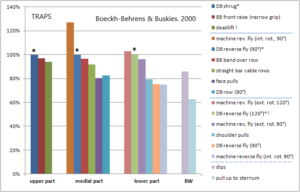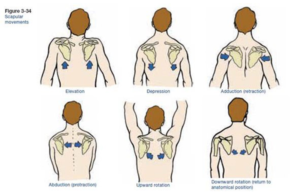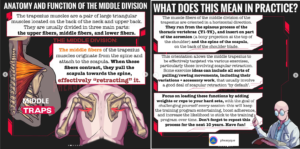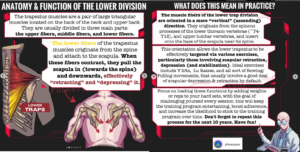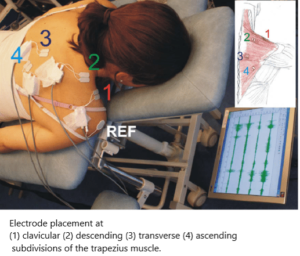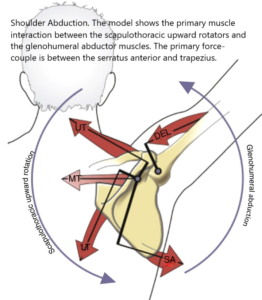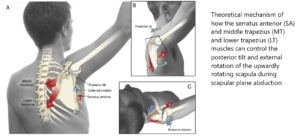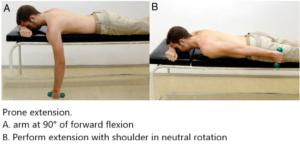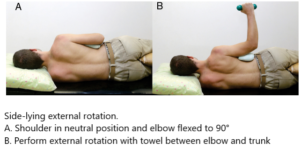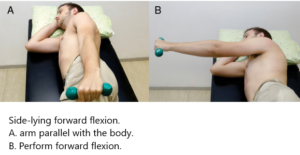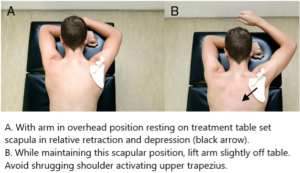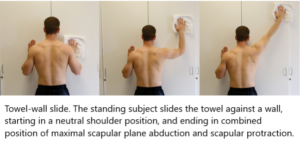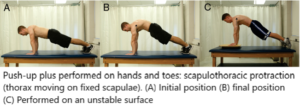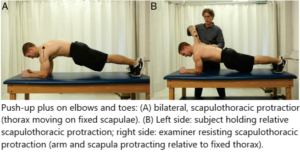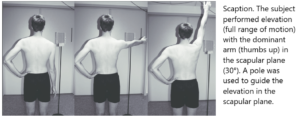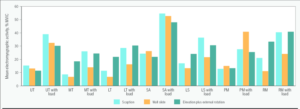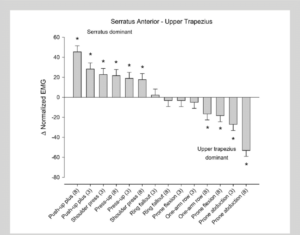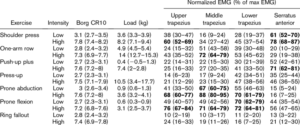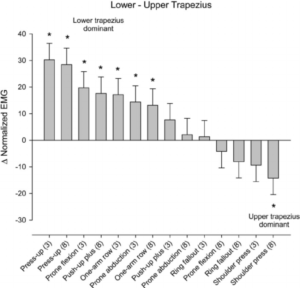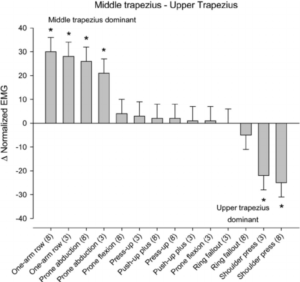UPPER-MIDDLE-LOWER TRAPEZIUS, RHOMBOIDS, LEVATOR SCAPULAE
Click on Image to Enlarge
TRADITIONAL 3 REGIONS
4 SUBDIVISIONS of the TRAPEZIUS
· There are 4 Parts to the Trapezius – CLICK HERE – source: Hamilton and Luttgens
Trapezius I
Origin: Occipital bone; ligamentum nuchae; Insertion: Posterior border of lateral third of clavicle
Action: Elevation of the Scapula
Action: Extension, Lateral Flexion, Rotation of the Neck
Trapezius II
Origin: Ligamentum nuchae; Insertion: Top of acromion process
Action: Elevation; Upward Rotation; Ad-duction (Retraction) of the Scapula
Trapezius III
Origin: Spinous processes of seventh cervical and upper three thoracic vertebrae; Insertion: Upper border of scapular spine
Action: Ad-duction (Retraction) of the Scapula
Trapezius IV
Origin: Spinous processes of fourth through twelfth thoracic vertebrae; Insertion: Root of scapular spine
Action: Upward Rotation; Depression; Ad-duction (Retraction) of the Scapula
4 SUBDIVISIONS of the TRAPEZIUS
Selective activation of neuromuscular compartments within the human trapezius muscle – 2009 – Holtermann
Procedure
– There are Task-dependent differences in relative activity b/n “functional” subdivisions within muscles
– Independent voluntary control of anatomical neuromuscular subdivisions is not observed
Electrodes
– Bipolar electromyographical electrodes were situated on 4 subdivisions of the trapezius muscle
Results
(1) All subjects managed to voluntarily activate the lower subdivisions independently from the upper subdivisions.
(2) Half of the subjects succeeded to voluntarily activate both upper subdivisions independently from the two lower subdivisions.
MOMENT ARM STUDY
THE SCAPULOTHORACIC MUSCLES – SERRATUS ANTERIOR & TRAPEZIUS
Kinesiologic considerations for targeting activation of scapulothoracic muscles – Trapezius
– Paula R. Camargo and Donald A. Neumann – 2019
Procedure
– This review provides the anatomy and kinesiology of the trapezius muscle with the underlying intention of understanding how this muscle contributes to the normal mechanics of the scapula as well as the entire shoulder region.
Results
Upper Trapezius: Shrugs with shoulders retracted · Overhead shrug
1
Middle & Lower Traps: Prone I-T-Y · Prone extension · Side-lying external rotation · Side-lying forward flexion · Elevation with external rotation
2
Lower Trapezius: Prone scapular setting
Kinesiologic considerations for targeting activation of scapulothoracic muscles – Serratus Anterior – Neumann, Carmargo – 2019
Conclusions
– Reduced strength, control, or activation of the SA has been implicated in pathological conditions involving the shoulder complex.
– These conditions include painful impingement of anatomic tissues, faulty glenohumeral kinematics, and scapular dyskinesis.
EMG STUDIES
UPPER, MIDDLE, LOWER TRAPS + SERRATUS ANTERIOR
– Prone Flexion “Y”, Prone External Rotation “W”, Standing Forward Flexion
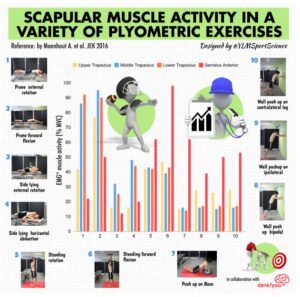 Scapular muscle activity in a variety of plyometric exercises – 2016 – Maenhout
Scapular muscle activity in a variety of plyometric exercises – 2016 – Maenhout
– Thirty-two healthy subjects
Results
Upper Trapezius: prone forward flexion thumbs up “Y” 75 · standing forward flexion overhead 45
Middle Trapezius: prone forward flexion thumbs up “Y” 95 · prone shoulder external rotation “W” 85
Lower Trapezius: prone forward flexion thumbs up “Y” 90 · prone shoulder external rotation “W” 90
+ Serratus Anterior: standing forward flexion 98% · standing external rotation 60% · BOSU pushup 60%
UPPER-MIDDLE-LOWER TRAPS, RHOMBOID, LEVATOR & SERRATUS ANTERIOR, PEC MINOR
– Scaption, Towel Wall Slide, Banded Elevation with External Rotation
Superficial and Deep Scapulothoracic Muscle EMG Activity During Different Types of Elevation Exercises in the Scapular Plane – 2015 – Castelain
Results for Exercises with Load
Serratus Anterior: scaption 55 –towel wall slide 50 –elevation with external rotation thera-band 45
Pectoralis Minor: towel wall slide 40 –scaption 30– elevation with external rotation thera-band 25
+ Upper Trapezius: scaption 40 – towel wall slide 35 – elevation with external rotation thera-band 30
+ Middle Trapezius: scaption 25– elevation with external rotation thera-band 25 – towel wall slide 15
+ Lower Trapezius: elevation with external rotation thera-band 30 – scaption 25– towel wall slide 15
+ Rhomboid Major: towel wall slide 40 – scaption 40 – elevation with external rotation thera-band 25
+ Levator Scapulae: scaption 35 – elevation with external rotation thera-band 30 – towel wall slide 25
UPPER-MIDDLE-LOWER TRAPS + SERRATUS ANTERIOR
– Prone Flexion “Y”, Prone Ab-duction “T”, DB Row, DB Overhead Press
Scapular Muscle Activity from Selected Strengthening Exercises Performed at Low and High Intensities – 2011 – Andersen
– Seventeen women (aged 24-55 years) without serious disorders participated
Results – High Intensity
Upper Traps: Prone Flexion Y 75 ·Prone Abduction T 70 · DB Overhead Press 60
Middle Traps: Prone Abduction T 90 ·DB Row 70· Prone Flexion Y 70
Lower Traps: Prone Flexion Y 70 ·Prone Abduction T 70 · DB Row 50
Serratus Anterior: DB Overhead Press 80 · Pushup Plus 70 · Prone Flexion Y 55
Exercises
1. DB Prone abduction with external rotation T: bench; abduct shoulders with thumbs pointing up until upper arm is horizontal; elbows slightly flexed
2. DB Prone flexion Y: bench; flex shoulders with thumbs pointing up until upper arm is horizontal, elbows slightly flexed
3. DB Overhead Press: sit upright; DBs in front of the shoulders; push DBs straight up until the arms are straight
4. DB row: 30º from horizontal; one knee on the bench; pulls DB toward the ipsilateral lower rib
5. Push-up plus: push-up position on hands and feet or knees; keep torso rigid; push the body as high as possible off the floor by protracting the scapulas
6. Press-up: sit upright, feet on floor; straight arms; palms on edge of bench fingers pointing forward; dip down moving just the shoulder girdle
7. Ring fallouts: on the knees with the hands in the gymnastic rings, which are suspended just above the ground level
UPPER-MIDDLE-LOWER TRAPS + LATS & BICEPS
– Lat Pulldown, Seated Cable Row, BB Row, Upright Row
 EMG of the biceps brachii, latissimus dorsi, and trapezius muscles during 5 pull exercises – 2005 – Handa
EMG of the biceps brachii, latissimus dorsi, and trapezius muscles during 5 pull exercises – 2005 – Handa
Procedure
– compare 5 different pull movements; 8 weight-trained men
Universal Machine Exercises
1. Lat Pulldown: medium pronated grip
2. Bent over Row: medium pronated grip
3. Seated Cable Row: narrow pronated grip
4. Upright Row: medium pronated grip
Results – 3 reps @70%RM
Note: I don’t know where the electrodes were placed for the latissimus dorsi
Trapezius – Upper: upright row 82% · bent over row 78% · seated cable row 42% · lat pulldown 29%
Trapezius – Middle: bent over row 90% · seated cable row 66% · upright row 66% · lat pulldown 48%
Trapezius – Lower: bent over row 87% · upright row 67% · seated cable row 56% · lat pulldown 55%
Latissimus Dorsi: seated cable row 82% · lat pulldown 78% · bent over row 64% · upright row 14%
+ Biceps Brachii: upright row 92% · lat pulldown 64% · bent over row 44% · seated cable row 41%
